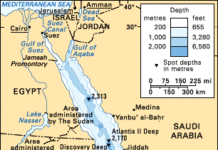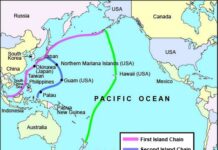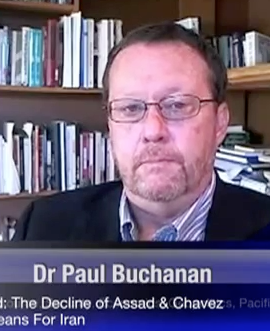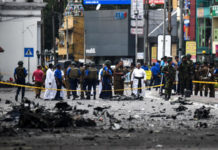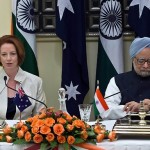Assessment Brief: Indian-Australian strategic co-operation in the early 21st century.
Balaji Chandramohan and Paul G. Buchanan
Introduction.
Australian Prime Minister Julia Gillard’s visit to India follows and will be followed by important politico-military changes in what has come to be known as the Indo-Pacific region. The foremost of these is strengthening defense co-operation between India, Japan, the United States, Vietnam, South Korea, New Zealand and Australia. The new strategic arc in the Indo-Pacific is outlined in two documents published by the United States government: the US Quadrennial Defense Review (2010) and the subsequent Pentagon document on strategic guidance titled “Sustaining Global Leadership: Priorities for Twenty-First Century (January 2012). A core of US strategy is to re-deploy military assets, including the bulk of its carrier and submarine fleets, in the Asia-Pacific region. With that re-positioning in mind, U.S. Secretary of Defense Leon Panetta recently asserted that defense cooperation with India is “a linchpin in US strategy” in Asia.
If India is a linchpin of US strategy in the Indo-Pacific, Australia is the hub around which the spokes of US power projection are extended through South-East Asia into the Southwestern Pacific and Indian Ocean. As aspiring Great Powers, India and Australia have begun pursuing bilateral strategic ties while strengthening their respective strategic relationships with other countries in the US-aligned strategic arc, including Japan, South Korea, Vietnam, Brunei, Malaysia, Singapore, Thailand and Indonesia (with overtures now being made to Myanmar). India has extended its reach further by starting to engage in security co-operation with New Zealand, which has its own web of defense links to the Indo-Pacific coalition. The core of the strategic ties that bind together the coalition (which has yet to be formalized into an alliance) is concern with rising Chinese power projection superimposed on historic rivalries and territorial disputes between coalition members and the Peoples Republic of China (PRC).
Although India and Australia have yet to reach consensus on specific aspects of their relationship, there is agreement on the need to place more importance on their bilateral relationship given their emerging convergence on strategic priorities in the Indo-Pacific region. Beyond the mutual concern with the PRC’s growing regional presence, other issues such as the need for stable government in Afghanistan and Pakistan and the need to fight piracy, human trafficking and other maritime criminal behavior help facilitate dovetailing of their respective strategic perspectives.
The recently published White Paper on Australia in the Asian Century confirms Australia’s commitment to strengthening its ties with and presence in the region. Although the emphasis of the Paper’s recommendations targets East and Southeast Asia, it would be remiss and incomplete if the Australian strategy in Asia did not include India as a significant component. Likewise, India cannot advance its interests in Asia without finding common ground with Australia on matters of strategic import.
India views Australia as the major United States ally in the Southern Hemisphere. Indian policy makers took special note of the 2012 trip to Australia by president Barack Obama and the US-Australian agreement to permanently base a 2500-troop strong US Marine Task Force in Darwin. Indian strategic planners increasingly view Australia as the vital cog around which the newly emerging security architecture in the Indo-Pacific is being built. They also accept at face value Secretary Panetta’s characterization of India as a linchpin of US security strategy in the Indo-Pacific and therefore want to be accorded a measure of respect commensurate with that status. That is as true for India’s relationship with Australia as it is for its relationship with the US.
That opens the door to potential disagreements. In spite of overtures such as Prime Minister Gillard’s recent state visit, many Indian decision-makers do not believe that Australia is ready to accept the fact that India is a great power in the Indo-Pacific. They perceive that Australian disregard for or downplaying of Indian strategic ambitions occurs in spite of India’s established role as a regional power in South Asia, where it sees itself to be a buffer against attempts by non-democratic regimes in the Eurasian heartland to spread their influence in Southeast Asia. They maintain that as part of that role India has been important in deterring potential threats to Australia’s sea lanes of communication, which given the export driven nature of the Australian economy has indirectly helped in Australia’s rise as a potential great power in its own right.
India points to concrete evidence of its commitment to the Indo-Pacific. After decades of working under a strategic perspective that gave primacy to its role as a continental regional power in South Asia, since the end of the Cold War India has moved to pursue a more balanced approach that includes development of a robust maritime strategy focused on power projection deep into the Indian Ocean and littoral waters of the Eastern Indian Ocean all the way to and through the Malaccan Straits. This revised strategic outlook was formalized in the Look East policy announced in 1991.
If not explicitly phrased as such, the Look East policy is primarily aimed at curtailing India’s self-defined greatest security threat, the PRC, in Southeast Asia. Indian strategic circles are largely united around the Look East policy, which has received support from other Southeast Asian countries such as Vietnam, Brunei, Malaysia, Singapore and Indonesia. It remains to be seen whether India’s Look East policy will find support in Australia, especially considering Australia’s existing commitments with the Five Power Defense Agreement in South-East Asia (including Malaysia, Singapore, New Zealand and the UK) and the existing balance of power that it has with Indonesia.
Indian force composition, strategic culture and civil-military relations.
The Look East policy does not entirely reverse but significantly alters Indian perceptions of core and peripheral security interests. Throughout its modern history India’s core security threats have been continental, with it fighting four limited land wars with Pakistan and one with China. This explains its continuing preoccupation with land-based threats and its pursuit of a nuclear deterrent.
The Indian Army is the second largest in the world in terms of uniformed personnel and receives the bulk of Indian defense spending (at 2.5 percent of GDP). The Indian military, which has the common tripartite division of service labor between air, naval and land forces, and a coast guard auxiliary, is organized as a traditional professional armed force with civilian control over the military. However, unlike its Antipodean counterparts and despite its primary external orientation the Indian army often is involved in internal security issues, specifically those involving counter-insurgency operations (COIN) against separatist and terrorist groups. The internal role of the Army is intimately bound up in the threat assessments of Indian intelligence and counter-intelligence, whose competence and orientation will be assessed later in the essay.
The Indian Army is organized as a regimental system along lines followed in other Commonwealth countries, but with the added factor of seven operational commands (Each command is headed by General Officer Commanding-in-Chief with the rank of Lieutenant General) modeled on the organization of the Soviet Red Army. That the Indian Army adheres to the rigid command structures of the Soviet system speaks to the problems involved in its transition from a geographically and demographically large country with marginal power to something more important.
India’s strategic culture permits a limited use of force for political objectives but has not traditionally been seen as expansionist or expeditionary. Political and military elite agreement on the limited use doctrine has helped preserve the status quo in civil-military relations. As in other democracies, India’s strategic culture is a product of the interaction between the civilian security bureaucracy (defense and foreign ministries), the military command and the political leadership, although in practice civilian input into military operational decision-making on strategic and tactical matters is limited by concerns about corporate autonomy and institutional interference.
Issues of importance related to military are not part of mainstream political discourse and periodic inter-elite disagreements on strategic matters have hindered the application of a consistent security policy over time. This leads to episodic contradictions in operationalizing Indian grand strategy, something that has been reflected in the occasional drift to or from pro-western and anti-western stances as well as calls for strategic autonomy.
In terms of formal organization of the national security apparatus, the National Security Council (NSC) (modeled on the United States) is the apex agency looking into the political, economic, energy and security concerns that are at the heart of Indian strategic policy.
The Chief Executive of the National Security Council is the National Security Advisor (NSA) who is also a member of the council. The NSA is the primary security advisor to the Prime Minister and the Indian Cabinet Committee on Security.
The three-tiered organization of the NSC includes the Strategic Policy Group (SPG), the National Security Advisory Board (NSAB) and the Joint Intelligence Committee, which is represented by a Secretariat (this secretariat functions under the cabinet secretariat).
The Strategic Policy Group consists of senior civil servants drawn from security-related agencies, the Chiefs of the three services, representatives from the intelligence community and the scientific advisor to the ministry of defense.
The JIC analyzes intelligence data from the Intelligence Bureau (IB), Research and Analysis Wing (RAW) and the Directorates of the three service intelligence agencies. There is very little intelligence co-operation with other intelligence agencies and there is no collection of data from external sources as the IB is wary of intelligence agencies of other countries penetrating its own ranks. Indian intelligence agencies do not usually share data with the Central Intelligence Agency and M15 (or those of their intelligence partners such as Australia), as it fears that the information could be passed on to Pakistan to which the latter agencies have active contacts. However, Indian intelligence agencies have close contacts with Israel’s Mossad, especially on counter-terrorist operations, given their common concern with Islamicist extremism.
Formed in 1968, RAW has an external focus and is modeled on the CIA. It has reportedly stopped its active espionage work following the so-called “Gujral Doctrine” (enunciated by Indian Prime Minister I.K Gujral in 1997). Interestingly, RAW’s funding is not included in the annual Indian budget so it is difficult to ascertain the full extent of its scope.
The IB has an internal focus and is officially under the Ministry of Home Affairs (MHA), but in practice the Director IB (DIB) is a member of the Joint Intelligence Committee (JIC) and Steering Committee and has the authority to brief the Prime Minister should the need arise. Otherwise, intelligence inputs go through the regular channels in the MHA to the JIC. The collection mechanisms of the IB vary depending on the region, but the IB operates both at the state level and the national level.
The Defense Intellligence Agency (DIA) formed in 2002 is headed by the Director General who co-ordinates inputs from the intelligence wings of the three armed services.
The Indian Army retains its own Military Intelligence wing, which is headed by a Director-General at the rank of Lieutenant General who reports to the Indian Army Chief (rather than the DIA). Army MI keeps a relatively low profile event though it has 700 officers and over 3,000 enlisted personnel. It is still tiny when compared to RAW and the IB, whose combined staff numbers are considered to be around 25,000. In recent years, Army intelligence has assumed a more significant role than the RAW in external intelligence collection. It works closely with India’s friendly countries such as Myanmar, Israel, Afghanistan and Vietnam.
The third tier of the NSC, the NSAB consists of persons of eminence outside the Government with expertise in external security, strategic analysis, foreign affairs and defence. It has no operational authority and serves as an advisory board to intelligence and political decision-makers.
The Ministry of Defence handles matters related to personnel, financial and resource management. All of the three military services have their own independent think tanks, with a newly formed policy-unit for Joint Warfare that reports to the Integrated Defense Staff which was set up in 2001 following the recommendations of the Kargil Review Committee which was formed following the Kargil border clash with Pakistan. The IDS is the first step towards the creation of the Chief of Defence Staff (CDS) which has not been taken by the Government as it not found consensus among Indian political parties. The primary aim of the Integrated Defense Staff and its policy unit Centre for Joint Warfare studies is to achieve integration and training of joint warfare professionals.
Integrated Defence Staff is headed by the Chief of Integrated Staff to Chairman, Chiefs of Staff Committee (CISC), to support the Chiefs of Staff Committee and its Chairman in the optimal performance of their roles and functions. The CISC supervises the Integrated Defence Staff, chairs all multi-Service bodies and the Defence Crisis Management Group (DCMG) and is also responsible for the coordination of long-range plans, five year plans and annual budgetary proposals of the three Services in consultation and co-ordination with the Integrated Services Headquarters.
Despite the existence of IDS, there is an active inter-service rivalry that is reflected in the inability to agree on a unified Chief of Defense Staff modeled on the United Kingdom or a Joint Chief of Staff such as that of the United States. That impedes provision of unified professional military advice to the civilian establishment. Rather than negotiate inter-service needs and wants within the confines of a Joint Staff before presenting agreed upon proposals to the civilian defense leadership, in India each service branch lobbies the civilian elite directly.
In spite of its purported limited use policy, India’s military doctrine is phrased offensively vis a vis Pakistan, with three strike corps based in Central India forming the basis for cross-border attacks. With respect to China India’s military posture is defensive in nature, although in recent times there has been an increased call for a Mountain Strike Corps to be formed. The difference between the two postures can be ascribed to the different sizes of the opponent’s forces as well as their respective strategic depths.
In line with the evolution of 3rd and 4th generation warfare concepts in other countries, in recent years Indian military emphasis has turned to joint military operations. The Integrated Defence Staff has released Joint Doctrines for the Armed Forces, including the Joint Amphibious Warfare Doctrine and the Joint Special Forces Doctrine. Tri-service commands have been established, such as the Andaman and Nicobar Command (2001) and the Strategic Forces Command (2006). Major joint exercises have been undertaken in an attempt to operationalize joint doctrines. AMPHEX 07, a tri-service amphibious exercise, serves as a prime example. Defence procurement procedures now emphasize ever more heavily the benefits of tri service coordination.
Proposed Joint Doctrines include the Joint Sub-conventional Warfare Doctrine, the Joint Psychological Operations Doctrine, and the Joint Space Doctrine. The three armed services also have their own respective doctrines that place greater focus on joint operations
India has sent expeditionary forces to countries such as the Maldives in 1988, Seychelles in 1986 and Sri Lanka in 1987. These Army-led operations were done with active participation of Indian Navy. India has sent troops as part of its commitment to United Nations peacekeeping missions. India considered sending troops to Fiji after the 1987 coup but decided that it was unable to do so because of the lack of logistical lift capability needed to carry out a deployment over that distance. One of the priorities of the maritime component of the Look East policy is to be able to project force over increased distance so that such deployments become feasible within the next decade.
On the sub-continent the Indian army has also acted as a type of praetorian guard for the regimes in neighboring small states such as Nepal and Bhutan. Further, as a commitment to the 2011 strategic partnership signed with Afghanistan, the Indian army has committed to “train, equip and facilitate capacity building programmes for Afghan national security forces” after the International Security Assistance Force (ISAF) drawdown is completed in 2014.
India’s military and security posture is driven largely in response to China’s military expansion while also seeking to maintain its position of strength relative to Pakistan (a Chinese ally). The PRC is already way ahead of India in terms of military capability, and its forward operating presence is already much greater as well. Not surprisingly, focus on catching up to and countering China has seen India direct increased resources towards upgrading its naval capabilities as well as modernizing its land and air forces in a measure disproportionate to the requirements of regional balancing. Even so, India has yet to develop a robust indigenous military-industrial complex befitting a great power, so unlike the PRC remains very reliant on weapons imports for military upgrading. Moreover, China now maintains a near constant naval presence in the Indian Ocean, with supply stations in Pakistan and the Seychelles part of the logistical chain involved in its “string of pearls” approach to forward naval operations.
With an approximate allocation of 50 per cent of the defence budget, the Army occupies the bulk of military expenditures, followed by the Air Force with 25 per cent and the Navy with 19 per cent. The Defence Research and Development Organization consumes six per cent of the defense budget, with the remaining funds allocated to Ordnance Factories. It is noteworthy that when compared to the previous decades’ defense budget, during the early 2000s the Indian Navy—the fifth largest in the world in terms of number of ships–has significantly increased its share of defense allocations. This demonstrates a shift within the defense establishment that if not altering the fundamentally land-based nature of the military triad certainly recognizes the need for a blue water naval capability if India is to effectively counter China and emerge as a great power in its own right. As a result, Indian naval priorities have shifted from coastal defense to maritime patrol and amphibious operations.
The Indian Navy conducts Theatre Level Operational Readiness Exercises annually in order to test the readiness of the fleet to respond to maritime challenges. In concert with the emphasis on joint operations, these exercises involve elements from the Indian Army, Indian Air Force and the Indian Coast Guard.
The Indian Navy has three commands – the Western, Southern and Eastern commands. The Eastern command has bases at Visakhapatnam (fleet headquarters) and Kolkata. Once the smallest of the Indian fleets, the Eastern command has grown remarkably in recent years. In 2005, it had 30 warships in its fleet. Six years later, that number has grown to 50 – roughly a third of the Indian Navy’s entire fleet strength. It is poised to expand further. It will soon have a forward base at Tuticorin and an operational turnaround base at Paradeep. In addition to naval air stations at Dega and Rajali, the Eastern command deploys the INS Parundu at Uchipuli, where UAVs are based.
The Eastern command is home to the Indian Navy’s submarine arm. India’s nuclear submarine Indian Naval Ship (INS) Arihant was constructed at Visakhapatnam. Two other nuclear submarines are reportedly being built there, and the nuclear submarine basing facilities in Visakhapatnam are being expanded (code name for the project is reportedly “Varsha”). This year it has taken possession of a Russian Akula II Class nuclear attack submarine, renamed the INS Chakra. Along with its nuclear submarines the Indian Navy currently operates 14 diesel powered submarines, which are based at Visakhapatnam and Mumbai (HQ of the Western Command).
India’s aircraft carrier INS Viraat is based in the Eastern command (although India is constructing two carriers in order to have a three carrier fleet that can protect both flanks of the Indian mainland—two deployed and one in reserve). Another Russian built carrier with a M-29 squadron is on order (INS Vikramditya, formerly the Admiral Gorshkov), but the Russian delivery as well as the indigenous construction efforts has been plagued by delays and cost overruns. That means that India is not anticipated to have a third carrier operational until at least 2018.
INS Vikramditya: Not yet deployed. Delivery date 2014.
All guided-missile destroyers (modified versions of Soviet Kashin class destroyers), which were previously part of the Western command, have joined the Eastern fleet. The amphibious vessel INS Jalashwa, previously the USS Trenton, has been put deployed under the Eastern command. It is joined by the indigenously manufactured stealth frigates INS Shivalik, INS Satpura and INS Sahyadri as well as US-manufactured P-8I Poseidon long-range maritime patrol aircraft and the Italian-made fleet tanker, INS Shakti.
The Indian Navy conducts annual multi-lateral naval war games involving the United States, Japan (most recently the ‘JIMEX 12’ bilateral exercise), Singapore and Australia (which participated in the 2007 exercise that was conducted in waters near India’s eastern command). India and the US have conducted more than 50 joint military exercises in the last seven years. It has extended its submarine patrols into places like the Gulf of Aden and South China Sea, including one reported encounter with Chinese warships conducting anti-piracy patrols off the Somalian coast.
The sum effect of these changes in force composition and deployment is that India is working hard to develop a blue water joint force expeditionary capability that is increasingly oriented towards the Indo-Pacific as a priority area of operations. Although it retains its majority focus on land-based threats due to the geopolitical position it finds itself in, India has formalized its commitment to the Look East strategy by strengthening its military capability and security relationships in the Indo-Pacific during the last decade, something that will continue in the years ahead.
The Strategic Impact of India on Australia.
During the Cold War Australia paid little heed to Indian strategic objectives. India did likewise with regard to Australia. Post-colonial affinities notwithstanding, India’s non-aligned orientation and limited power projection capacity, the latter only slightly worse than Australia’s itself but the former in stark contrast to the strong pro-US orientation of the Australians, made bilateral concerns inconsequential in either country’s strategic thought. Add to that very different domestic political imperatives governing electoral politics in two very different types of post-colonial democracies, and the need to prioritize bilateral strategic concerns was negligible.
The end of the Cold War and the dissolution of the bipolar balance of power international system amid a rising tide of economic globalization forced reconsideration on both sides of the bilateral divide with regard to their respective positions in the Indian Ocean. As the 1990s gave way to the 2000s, the areas of strategic overlap between the two countries extended into Southeast Asia and, more recently given India’s ambitions, the Western Pacific.
The 2009 Australian Defense White Paper recognized India as an emerging great power and noted the potentially shared threat to both posed by China’s growing military might. The paper also pointed out that the Indian Ocean will have great significance for world economic flows by 2030 and that issues of maritime piracy and smuggling will also be more prominent in the years to come. That is where India-Australia interests intersect.
Australia’s core security interests lie in the Southwestern Pacific and the Indian Ocean. These overlap but are not identical to those of its major allies, particularly the US. Australia started to pursue self-reliance policy for its defense following the Guam Doctrine announced by the US during the Nixon Administration. The Guam Doctrine saw the need for US allies, Australia in particular, to be as self-reliant on defense and security matters as possible, all the while continuing to strengthen bilateral military-to-military ties with the US. Every Australian defense White Paper since 1976 has adhered to that vision. Australia’s pursuit of strategic self-sufficiency following the Guam Doctrine allowed the US to encourage its rise as an allied regional power in Asia Pacific.
Although India’s Look East policy has as of yet not fully extended through the Malaccan Straits, in the next five years it is envisioned that India’s eastern outreach will expand diplomatically in the South Pacific, particularly in Australia, Fiji, New Caledonia and New Zealand. Each of these countries has important political and cultural ties with India. Fiji’s domestic demographic contains a population in which nearly 40 percent are identified as “persons of Indian origin.” For their part, Australia, New Caledonia and New Zealand have sizable and long-established Indian expatriate communities. These communities wield significant economic and political influence in each country and provide an open source conduit for information exchanges between the Southwestern Pacific neighbors and the Indian homeland.
To be sure and in contrast to perceptions of the Chinese diaspora in the South Pacific, the Indian expatriate community is diverse in its loyalties and not as unified in its support for the Indian state or any particular political party. It is therefore not considered to be a source of espionage or influence-peddling in the measure that its Chinese counterparts are, however mistaken the latter belief may be. Whatever the case, the Indian expatriate presence in the South Pacific has the potential to facilitate Indian soft power projection in the Southwestern Pacific, particularly given the post-colonial cultural and ethnic ties that bind India to Fiji and the Antipodes.
Diplomatically, India has shown interest in the South Pacific affairs by participating in the Pacific Islands Forum (PIF) annually from 2002. India also has begun to provide foreign aid to the islands in the South Pacific by offering soft loans for development projects. Along with aid programs from traditional donor states such as the US, Australia and New Zealand as well as those of Western based charities and non-governmental agencies, this is seen as a soft power counter to the rising Chinese presence in the South Pacific. Somewhat surprisingly, however, India has not sent a Prime Ministerial delegation to Australia or New Zealand for three decades, which points to the lack of priority given to the Antipodes by Indian policy-makers in the recent past.
India has no military presence in the Pacific, but this may change in the next five years as India starts increasing the Eastern Command’s operational capabilities. Given its expanding commercial engagement with Southeast Asia and Western pacific, it would seem like a natural evolution for its navy to participate in maritime patrols along the sealanes involved. For that to happen however, it will have to secure the support of Australia, New Zealand, the US and the other states that comprise the strategic arc that acts as a containment mechanism on Chinese military ambitions in the region.
At the moment India is diplomatically extending its Look East policy via the provision of aid to South Pacific island countries (both bilaterally and through the PIF), is strengthening its naval operational capabilities along the Eastern Indian Ocean, and by involving itself in bi-lateral and multi-lateral military exercises with countries in the Indian Ocean and South Pacific. In terms of Indian strategic planning, Australia is expected to act as an important springboard from which the US will pursue its forward presence in Indo-Pacific region. It is expected that this will be confirmed by the findings of the upcoming 2013 Australian Defense White Paper.
For its part, in its capacity as an emerging regional power Australia has started to “Look West” beyond Indonesia. Diplomatically, Australia participates as an observer in regional multilateral summits such as the South Asian Association of Regional Co-operation, and actively participates in the Indian Ocean Naval Symposium and in the International Security Assistance Force (ISAF) in Afghanistan (Operation SLIPPER). Australia’s military contribution to ISAF includes an annual average of 1,550 Australian Defence Force personnel deployed within Afghanistan. In contrast, Australia’s bilateral military ties with India are confined to educational exchanges and participation in multinational military exercises.
Australia and India share concerns about Chinese military expansionism in the Indian Ocean, something that in Australia’s case is added to an extant concerns about Chinese blue water operations in the Southwestern Pacific. The two oceans carry the vast majority of Australia’s exports and imports, and therefore are considered national lifelines worthy of priority protection. In light of this, Australia’s strategic re-orientation requires upgrading and expanding of its Navy. Australia’s 2009 defence White Paper called for a major expansion of the submarine fleet from six to twelve boats by 2030.

HMAS Waller (SSG 75) .
HMAS Stirling, also known as Fleet Base West, is the largest base in the Royal Australian Navy. Providing Australia’s Indian Ocean presence, the base is located on Garden Island south of Perth, Western Australia. Eleven fleet units are based at HMAS Stirling including the headquarters of the Australian Submarine Squadron. It is also expected that the US Navy will have on-going access to HMAS Stirling in the future (US carriers currently make regular port calls at Garden Island).
To this can be added the Australian forward presence in the Cocos (Keeling) islands, consisting of two atolls and 27 islands some 2,950 kilometers northwest of Perth and 1,272 kilometers southwest of Jakarta. The islands serve as a refueling stop and forward base for the Royal Australian Air Force’s P-3 Orion Indian Ocean surveillance fleet. In the years to come, the Cocos islands could become for Australia what the Andamans and Nicobar islands are to India, since the existing airfield can be upgraded to support the latest generation P8-A Poseidon maritime patrol aircraft and the world’s largest drone, the US-built Global Hawk. This possibility was emphasized by the 2012 Australia’s Defense Posture Review The Australian Defense Posture Review also mentioned that the Cocos Islands could serve as a spring board for joint US-Australian operations and power-projecting capabilities in the Indian Ocean.
In effect, the Western Fleet will be the foundation of Australian force projection in the Indian Ocean, where it will overlap with the Indian Eastern Fleet’s area of responsibility.
Summation.
The question is whether shared strategic concerns and their respective diplomatic and military initiatives in the Indo-Pacific will translate into a strategic partnership between Australia and India.
Although it would seem that the overlap in their shared strategic interests advises in favor of a partnership, whether or not they do so depends on a number of potential contextual factors, including the following (assessments of probability in bold):
a) An increased Chinese military presence on India’s Northern border or renewed tensions with Pakistan could see India shelve or curtail plans for its naval expansion in favor of a re-emphasis on reinforcing Army and Air Force capabilities. 36th Parallel sees this as a having low probability.
b) If the situation in Afghanistan worsens with the withdrawal of the International Security Assistance Force (ISAF) in 2014, India might consider sending troops as a part of its commitment to the United Nations Peace Keeping Forces in Afghanistan. At present India spends US $2 Billion for development projects in Afghanistan, which could increase after 2014. A troop commitment could be justified as force security for the developmental projects. This move would likely be welcomed by Australia as it draws down its own force commitment to ISAF, but would be unwelcome by Pakistan. 36th Parallel considers the probability of India sending troops to Afghanistan to be low but sees Indian provision of continued developmental assistance to be high .
c) If the political situation in Fiji worsens on the path to the scheduled September 2014 elections, leading to their postponement or cancellation, India will likely support the military regime in Fiji in contrast to Australia’s continued call for democracy. That is due to the Baimimarama regime’s support from the majority of Fijian Indians and concerns about continued Chinese influence in Fiji in the absence of a countervailing diplomatic presence. The view that ongoing diplomatic engagement is required in Fiji is likely to be shared by the US. Since Australia has begun to soften its stance vis a vis the Baimimarama regime, even if it reverts to a position of strong opposition in the face of electoral cancellation or postponement, this should not negatively impact on the Australian-Indian bilateral relationship. 36th Parallel foresees that potential differences with regards to diplomatic approaches towards Fiji will not impede broader bilateral cooperation between Australia and India.
d) Based on their past behavior of establishing strategic priorities based on hard power-politics and supporting a strong military, the greatest possibility for increased defense co-operation will occur in the event right-leaning governments are at the helm in each country. Australia has elections scheduled for 2013 and India for 2014, with Left-Center coalitions currently in power. 36th Parallel sees this as a moderate possibility.
e) India and Indonesia have signed naval co-operation and defense agreements. If the political situation worsens in Aceh and Papua provinces of Indonesia there is a chance that India and Australia might disagree on the proper approach to those conflicts. This could impact on Australian-Indian bilateral relations if India supports the Indonesian position in the face of Australian disagreement. 36th Parallel views this as a potential roadblock to an Australian-Indian strategic partnership.
f) If the Canak independence movement in New Caledonia continues to grow, given the significant Indian-origin population in the French overseas territory, India might attempt to play a diplomatic greater role in resolving the dispute given its historical ties to the Melanesian country. This move would have to be approved by the French, but could be an area of understanding between India and Australia. 36th Parallel sees such a move as being a low possibility.
g) Bilateral trade between India and Australia is worth US $20bn and is growing at the rate of 20% every year. This may act as a catalyst for strengthening the strategic relationship given the established linkages historically made between trade and security (trading partners tend to preferentially be security partners and vice versa). A Free Trade Agreement between India and New Zealand (now in discussion) could accelerate moves towards an Australian-Indian FTA. 36th Parallel sees this as a distinct possibility.
h) With increased Chinese naval expansion in the Indian Ocean and South China Sea, India will strengthen operational capabilities of the Eastern Fleet and Autralia will do likewise with its Western Fleet based in Perth. Both of these fleets will increase their engagement with the US Navy Fifth and Seventh Fleets. 36th Parallel sees this as a high possibility.
Assessment.
Growing economic ties, overlapping security concerns and distinct cultural, diplomatic and historical links suggest that a bilateral strategic partnership between Australia and India is a real possibility. This is especially true if conservative governments come to office in either or both countries in the next few years.
Futures Forecast: Australia and India will begin to explore a bilateral strategic relationship by the end of the decade.
Links
http://www.globalsecurity.org/intell/world/india/index.html
http://www.ndtv.com/article/india/how-indian-navy-is-expanding-and-modernising-235746
http://ids.nic.in/welcome.html
http://mod.nic.in/aforces/welcome.html
http://indianarmy.nic.in/Index.aspx?flag=cKFtkfylp/mRA5GkEnyaYg==
http://www.india.embassy.gov.au/ndli/home.html
http://www.indiandiplomacy.in/HTML.aspx?name=topstories&topskrc2=111
http://pib.nic.in/newsite/erelease.aspx?relid=88371
http://www.tribuneindia.com/2011/20111009/edit.htm#1
http://idsa.in/book/GrandStrategyforIndia2020andBeyond
http://meaindia.nic.in/mystart.php?id=530119048
http://www.india.embassy.gov.au/ndli/pa5009jsb.html
http://www.securitychallenges.org.au/ArticlePDFs/vol6no1Brewster.pdf
http://ids.nic.in/research.htm
http://164.100.47.134/lsscommittee/Defence/36th%20Report-UNIFIED%20COMMAND.pdf
http://164.100.47.134/lsscommittee/Defence/FINAL%20DFG%20%20REPORT%20-2012-13.pdf
http://mod.nic.in/reports/welcome.html
http://www.mea.gov.in/Portal/ForeignRelation/China-January-2012.pdf
https://ids.nic.in/Indian%2520Army%2520Doctrine/indianarmydoctrine_
http://www.idsa.in/idsacomments/ReopeningtheDebateonLimitedWar_aahmed_290212
http://www.southasiaanalysis.org/node/1014
http://www.pm.gov.au/press-office/transcript-press-conference-new-delhi-india-0
http://www.defence.gov.au/oscdf/adf-posture-review/docs/final/default.htm#
http://www.aii.unimelb.edu.au/news/india%E2%80%99s-naval-mission-deep-blue-sea
http://www.ausairpower.net/APA-2012-01.html
http://www.navy.gov.au/fleet/ships-boats-craft/submarines/submarine-names
http://www.navy.gov.au/media-room/publications/future-maritime-operating-concept-2025
http://www.defenseindustrydaily.com/Australias-Next-Generation-Submarines-05917/
http://asiancentury.dpmc.gov.
Balaji Chandramohan is the Asia Pacific correspondent for World News Forecast, a United States- based future news agency.



